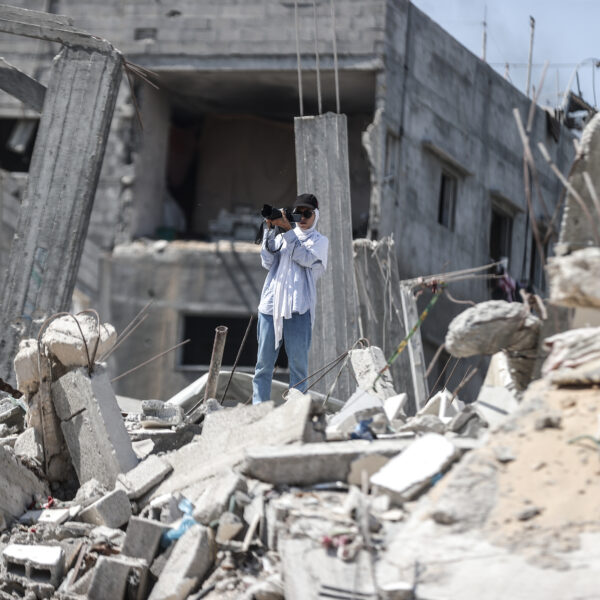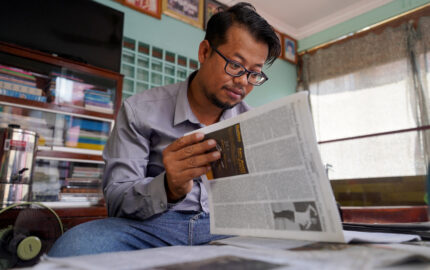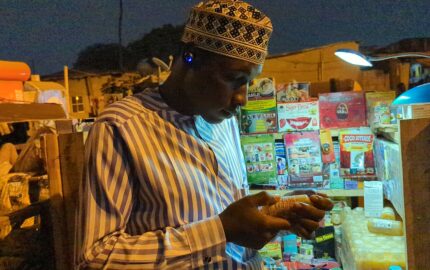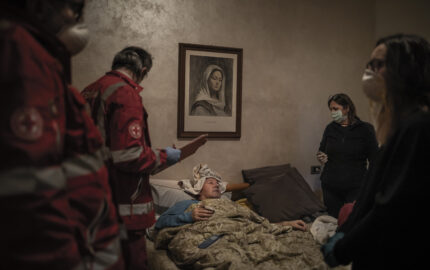Shrouq Aila, a freelance journalist based in central Gaza, navigates a city under siege with her toddler by her side to tell the world what’s happening.
She does this while she slowly starves. Aila weighed 62 kilograms — approximately 137 pounds — in October 2023. Today, she weighs 47 kilos — or just over 100 pounds. She has been displaced from her home, narrowly survived two deadly airstrikes when her daughter was just an infant, and continues reporting even as famine and exhaustion gnaw at her.
She worries about taking public transportation with her daughter out of concerns for her safety, and shared cars are little better: “There are too many men in the car that I don’t know. Sometimes a car has around 20 or more people, which is unsafe,” she said. Each time she leaves home to report, she either has to bring her toddler along, or shell out over $200 for gas for her car so she can drop the child off with her parents. It’s a hefty expense at any time, and doubly so when getting cash means paying 50% in fees to a black-market broker.
She is reporting the story as she lives it, and she’s not alone.
After her husband, Roshdi Sarraj, a co-founder of Ain Media, was killed in an Israeli strike on Oct. 22, 2023, Aila stepped in to run the company, which provides professional media services to international and local outlets. She continues filing daily news reports and coordinating documentary work for foreign and Arabic broadcasters, often typing on her phone amid patchy electricity and faulty network service to ensure Gaza’s stories reach the outside world.
Whenever you read reporting from Gaza, it’s because of the dedication of Aila and hundreds of journalists like her — although there are fewer each day.
As of October 8, 2025, CPJ’s preliminary investigations showed nearly 240 journalists and media workers have been killed in Gaza, Yemen, Lebanon, Israel, and Iran since the start of the war — which followed a Hamas-led terror attack in Israel on Oct. 7, 2023 — making it the deadliest period for journalists since CPJ began gathering data in 1992. The vast majority of those killed are Palestinian journalists in Gaza, at least two dozen of them in targeted attacks by Israel that the CPJ describes as murders. On Aug. 25, strikes on a hospital in southern Gaza killed five journalists working for Reuters, the Associated Press, and Al Jazeera, among others. Over two years since the war in Gaza began, local journalists have faced displacement, famine, targeted attacks, and death with no respite, despite growing calls for protection from international organizations and media outlets.
The severe shortages of food, clean water, fuel, and medical supplies in Gaza affect journalists and aid workers as much as any other resident. But with foreign journalists barred from entering unless under Israeli military escort, local journalists in Gaza remain the world’s only witnesses to the war and its atrocities. They are starved, traumatized, displaced, killed — yet managing to continue reporting from one of the most dangerous places on Earth.
Abdalwahab Hamad, a correspondent with the Turkish Radio and Television Corp.’s TRT World, struggles to report from Gaza while facing starvation himself.
“I worry about my family, and at the same time, I have to stay physically strong to continue reporting daily,” he said. “It's not easy, and sometimes I don't know where I get the strength to go in front of the camera and to continue reporting, especially when Israel continues to kill journalists on a daily basis.”
The United Nations in August declared a famine in Gaza, citing projections from the Integrated Food Security Phase Classification (ICP) that more than 640,000 people would face “catastrophic levels” of food insecurity by September, even as Israel repeatedly denied the claims and called the reports “lies.”
On Sept. 16, an independent U.N. inquiry for the first time alleged that Israel has committed genocide against Palestinians in Gaza, and accused Israel’s top leaders of incitement. The report found that four genocidal acts had been carried out since Oct. 7, 2023. Israel’s foreign ministry denounced the findings, calling the report “distorted and false.”
But under growing international pressure amid scenes of starving children, Israel announced limited humanitarian pauses on strikes to allow for airdrops meant to get food to over 2 million Gazans who rely largely on outside aid after nearly two years of war. In August, a handful of commercial trucks were allowed in, but Aila calls the supplies “a drop in the ocean.”
Crippling fuel shortages make transportation unaffordable and food prohibitively expensive, and the U.N. says the Israeli authorities’ restrictions on the movement of aid trucks, as well as criminal looting, are hampering response efforts. This leaves desperate, starving people to risk their lives at distribution sites that Aila described as “traps,” where they face direct fire and missiles. “It’s unfiltered brutality,” she said.
Even when resources are available, accessing them is its own job; Agence France-Presse’s (AFP) global editor-in-chief, Mehdi Lebouachera, said their journalists often trek long distances to obtain food from aid distribution sites or the black market. He described how one of their journalists went to cover food distribution on the Gaza beach, more than nine miles from the city. After he spent his day covering the story and finding food for his family, he then walked home with his gear and flak jacket — more than 15 miles in a single day. “It is horrendously difficult to work in Gaza right now,” Lebouachera added.
The toll is visible on their bodies. Like Aila, many reporters have lost drastic amounts of weight, Jodie Ginsberg, the CPJ’s CEO, said. “Many fear for their lives. Journalists are exhausted and desperately hungry — some have gone whole days without food, reporting dizziness and collapsing. At least three have fainted live on air; one required hospitalization and IV treatment,” Ginsberg said.
In a statement issued July 23, the CPJ said, “Israel is starving Gazan journalists into silence.” It joined an urgent appeal from more than 100 aid agencies to end Israel's starvation of journalists and other civilians in Gaza, as they called on states to “save lives before there are none left to save.”
The psychological strain is equally severe. Journalists, Hamad said, are traumatized by witnessing colleagues and friends being killed simply for reporting. “Journalists here have this compounded suffering where they are extremely food insecure, but at the same time, they have to be strong enough to get in front of a camera and to continue reporting, especially as Israel continues to reject the entry of international media in Gaza,” he added.
Famine is exacerbated by the constant cycle of displacement, which is itself exacerbated by cash, fuel, and housing shortages. Like most Gazans, Hamad and his family have been displaced several times since the start of the war, in Hamad’s case, 11. He now lives in the Deir al-Balah refugee camp, the smallest in the Gaza Strip. In these overcrowded camps, access to food and clean water is limited; 90% of the water in Deir al-Balah is unfit to drink, according to the United Nations Relief and Works Agency for Palestine Refugees in the Near East (UNRWA).
Aila too has cycled between tents and temporary apartments. “I lived in a tent for six months, it was the worst nightmare I ever endured, and I don’t want to go back to that era,” she said. Her whole family, including her siblings, has been displaced since the start of the war. But she hasn’t been able to find any longer-term housing in Gaza City, adding, “There are no houses left.”
Nor is there anywhere left to go. “Since we heard about the potential occupation of Gaza City, I’ve been looking for places to rent in central Gaza City and in the south and unfortunately, I cannot find any,” Aila said. “The entire Rafah City in the far south is already occupied. ...Almost 2 million people are trapped in a very limited area, under [extreme temperatures], in makeshift tents that never protect you from heat or winter.”
If Aila were to find a place, paying for it would be her next obstacle. Since October 2023, Israel has not allowed any large injection of physical cash to enter Gaza. Banks and ATMs have either been shut down or destroyed, making way for black-market cash brokers to move in who charge exorbitant amounts to withdraw money. There is almost no way to access cash in Gaza now without paying up to 50% in fees to the brokers.
Lebouachera said AFP journalists find it extremely difficult to get paid. “We need to pay our journalists, but there is no way to pay them cash, electronically,” he said, while confirming that money change agents charge 40% to 50% of the requested sum. “If you’re trying to get $100 USD, you end up paying between $40 and $50. The conditions are pretty dire,” Lebouachera added.
This means that every $200 Aila spends driving her daughter to and from her parents’ home started out as $400. Traveling for work comes with another challenge: soaring fuel costs. Aila says fuel that once cost $2 a liter now costs nearly $150 — impossible for most. A short ride into the city can take hours, sometimes days, to plan, with journalists paying double in cash fees just to afford the trip.
“How do you cover anything if you don’t have access to a place, or the proper conditions to report? What’s at stake is showing the world what’s going on.”
— Mehdi Lebouachera, global editor-in-chief for Agence France-Presse
Staying home — for those who have a home to stay in — isn’t an option, especially for a journalist trying to tell Gaza’s story.
“We survived being pulled out of the rubble twice, my daughter and I,” Aila explained. “So I am super, super terrified about [leaving her alone], and that's why I have to use my car. Then in the past few days, I had some work in the south and some in the north, and it cost me, on a daily basis, $200, which is insane. Otherwise, moving around the city takes around $100 a day.”
To file stories, journalists must trek to the few designated sites that still have electricity and internet service, Aila said. “We have some tents used by the press that are provided with electricity and internet access. So, I can go to upload the material that I capture and also to charge my devices,” she added.
In the absence of regular public transportation, fuel shortages, and rising costs, some civilians and journalists in Gaza have resorted to using donkeys for traveling long distances. For many, including Hamad, their livelihoods depend on them. “Sometimes I walk long distances due to lack of fuel, and sometimes take a donkey cart. When I need to go farther, I wait hours to find public transportation. It is very difficult and extremely expensive,” Hamad said, adding that movement is very restricted, public transportation is costly and hard to find, and almost every journalist in Gaza feels their movement is tightly controlled by the Israeli military. They live with constant fear, he said, knowing their rights to safety and security have been violated repeatedly.
Nearly a month before he was killed by an Israeli airstrike, 28-year-old Al Jazeera correspondent Anas al-Sharif broke down crying during a live telecast while highlighting the extreme physical and psychological toll the situation in Gaza was having on the population — and on him personally. Al-Sharif was killed in August along with three of his colleagues from Al Jazeera when the airstrike hit a media tent sheltering journalists outside the main gate of Gaza City’s al-Shifa Hospital.
Days before al-Sharif’s death, the CPJ said it was “gravely worried” for his safety, asserting he was being targeted by an Israeli military smear campaign falsely accusing him of being a Hamas terrorist, which he believed was a precursor to his assassination. “We've seen numerous instances of journalists being accused of being terrorists, prior or after a direct hit on a journalist,” said the CPJ’s Ginsberg. “We believe that the smears are a deliberate attempt to delegitimize Gazan journalists and cast doubt on the veracity of their reporting, so that Israel can control the narrative from its side,” she added.
According to Lebouachera, AFP’s journalists have also faced smear campaigns. “That has been going on since the beginning of the war now. …Our journalists are vetted, they’re working under strict guidelines, with strong ethics,” he said.
An investigation by the Associated Press and other news outlets revealed that the Israeli military strike on Nasser Hospital in Gaza that killed five journalists on Aug. 25 involved four successive strikes. Israel called the attack a mishap, claiming it had been aiming at what it believed was a “Hamas camera” being used by militants to track Israeli forces. That justification was strongly objected to by the AP (and Reuters), which conducted an investigation after Mariam Dagga, who worked for the AP and other outlets, was among those killed in the attack. The AP and Reuters found that the camera in question was operated by a Reuters photojournalist — also killed in the attack — and said that Israel had both the technology and the capability of verifying that information.
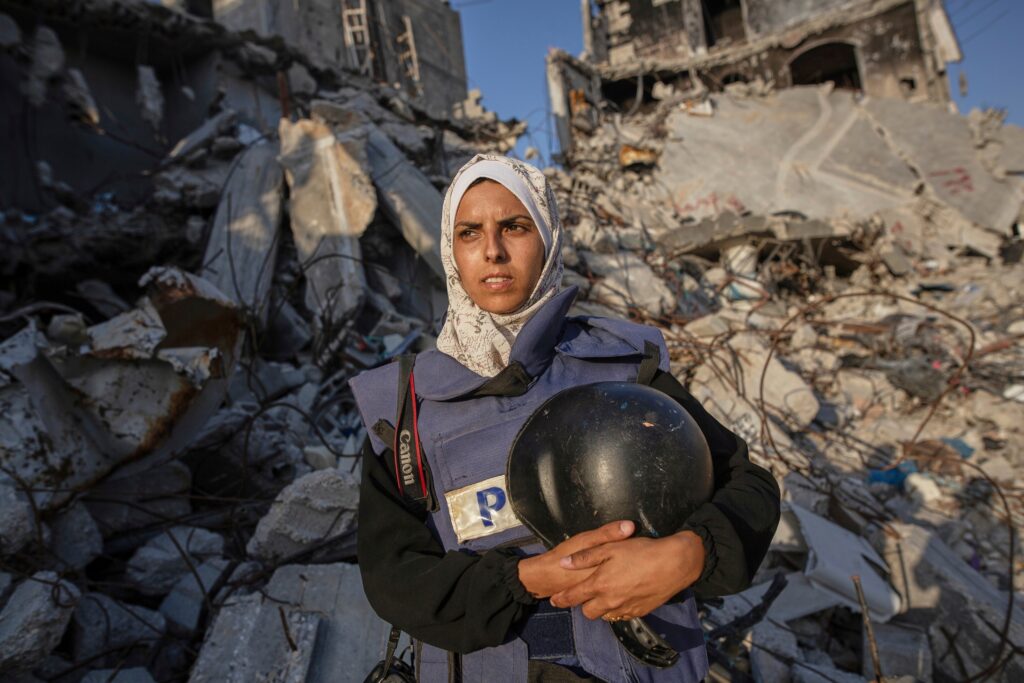
Lebouachera stressed the critical need for diplomatic efforts to evacuate journalists from the area. After evacuating some team members early in the war, the newswire’s efforts have hit a wall. “Only a state can intervene with Israel to take people out. …There's no administration in Gaza. Some people have lost passports and IDs. …There are so many hurdles,” he said.
With the foreign press blocked, Palestinian journalists are the last independent witnesses. “I cannot remember a time where we did not have access to a zone for so long,” said Lebouachera. “How do you cover anything if you don’t have access to a place, or the proper conditions to report? What’s at stake is showing the world what’s going on.”
Gaza’s reporters have endured displacement, famine, and exhaustion, and still face the threat of being silenced outright.
Aila knows this, and still refuses to leave. “I had the opportunity to evacuate, but I refused. I cannot leave while many of my loved ones, my siblings, friends, family, and my husband’s family remain behind,” she said. “I prefer any kind of evacuation to include all the people I care about.”
